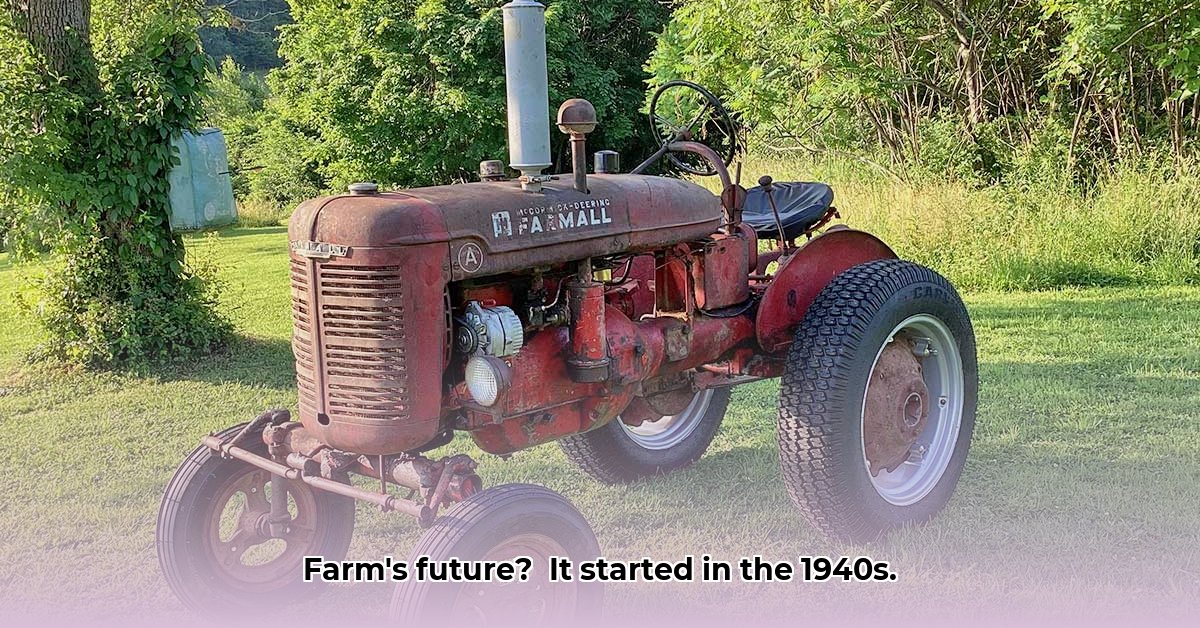
A Revolution in the Fields
Imagine the American countryside of the 1940s. The rhythmic clip-clop of horses pulling plows is gradually replaced by a new, powerful sound: the rumble of the tractor engine. This wasn't merely a technological upgrade; it was a fundamental transformation of American agriculture. World War II fueled a massive demand for food, both domestically and for Allied forces. However, a critical shortage of farmhands – many men were fighting overseas – presented a significant challenge. The solution? Mechanization. Powerful tractors, capable of performing the work of numerous laborers, ushered in a revolution. Did this technological leap truly benefit agriculture, or did it come at a cost? For more on early tractor models, check out this site on older tractors.
The Iron Horse Takes Over
The tractors of the 1940s weren't simple motorized versions of previous equipment. Innovative engineering made them far more efficient and versatile. The three-point hitch (a system for easily attaching various implements like plows and harrows) proved revolutionary. Improved hydraulics allowed for smoother operation and reduced strain on both the machine and the operator. A farmer could effortlessly switch from plowing to planting, a stark contrast to the backbreaking labor of horse-drawn equipment. This increased efficiency was a game-changer. How did this shift in technology impact the average farmer's workload and lifestyle?
Technological Advancements That Changed Farming
These improvements didn't emerge overnight. Engineers dedicated themselves to creating better, faster, and more efficient machines. The adoption of pneumatic tires (air-filled, rather than solid rubber) vastly improved traction, enabling tractors to work on diverse terrains. More powerful engines allowed farmers to cultivate larger areas, dramatically increasing output. Before this era, farm production was severely limited by the physical capabilities of human labor. What specific engine advancements were most critical to this increased efficiency?
Did this increased productivity truly translate into lower food prices for consumers? Evidence suggests that the increased food production did contribute to lower consumer prices for many food items, particularly in the post-war boom. This positive impact, however, needs to be weighed against the other significant changes occurring in the agricultural landscape.
More Than Machines: The Human Story
The shift to tractors wasn't solely about technology; it profoundly impacted the lives of American farmers. Farmers accustomed to working with horses had to learn to operate and maintain sophisticated machinery, a steep learning curve for many. Family dynamics shifted as younger, more technologically adept generations took on new roles. "The mechanization of agriculture significantly altered the social fabric of rural communities," notes Dr. Sarah Miller, agricultural historian at the University of California, Davis. "It led to a decline in farm labor, causing both economic hardship and social disruption for many families." This created a complex interplay of progress and adaptation.
Weighing the Costs and Benefits: A Complex Equation
The transition to tractors wasn't without its downsides. The initial cost was substantial, creating a significant barrier for smaller farmers. This economic disparity contributed to the consolidation of farms, potentially forcing smaller, independent operations out of business. “The high capital costs favored larger farms, leading to a significant shift in the agricultural landscape and the loss of many small farms,” explains Professor Robert Jones, Department of Agricultural Economics, Purdue University. This situation, then, created winners and losers.
| Factor | Advantages | Disadvantages |
|---|---|---|
| Efficiency | Increased output; more land cultivated. | High initial cost; accessibility challenges (especially for smaller farmers). |
| Productivity | Faster processes; higher yields. | Increased maintenance and repair costs; specialized knowledge required. |
| Labor Requirements | Reduced manual labor. | Job displacement; need for retraining and adaptation. |
| Land Utilization | Improved land management, efficient use of acreage. | Potential for soil erosion or depletion without proper soil conservation practices. |
Despite the challenges, the benefits of increased food production were undeniable. This played a crucial role in ensuring food security and stabilizing food prices post-war, benefiting a growing population.
A Legacy That Continues
By the end of the 1940s, the tractor had irrevocably altered American agriculture. While the transition presented significant challenges, the long-term impact on productivity was transformative. It laid the foundation for modern, large-scale farming. The legacy of the 1940s tractor revolution remains a complex story of adaptation, innovation, and the enduring impact of technological change on our food system.
How Did 1940s Tractor Technology Impact Long-Term Soil Health?
The 1940s tractor boom fundamentally changed farming practices, with lasting consequences for soil health. While boosting productivity, early tractors, often lacking advanced features, tended to compact soil, reducing water infiltration and aeration. This compaction negatively impacted long-term soil fertility. However, the increased efficiency allowed for practices like crop rotation and cover cropping, ultimately improving soil health. Later technological advancements, like improved tire designs and hydraulic systems, further minimized soil compaction. The transition's economic and social impact also influenced soil management practices, creating a complex interplay of positive and negative consequences. The 1940s marked a pivotal period in agricultural mechanization and its impact on sustainable soil management, a legacy that continues to be examined and refined.